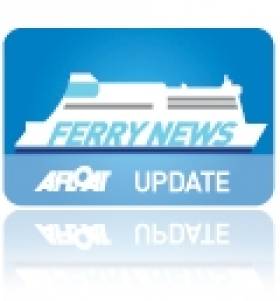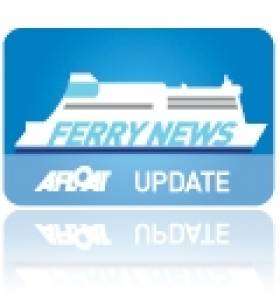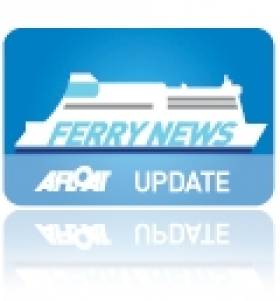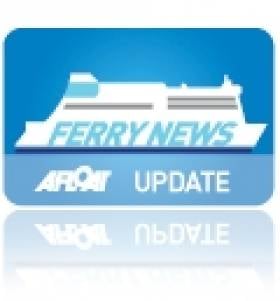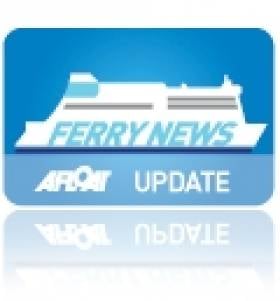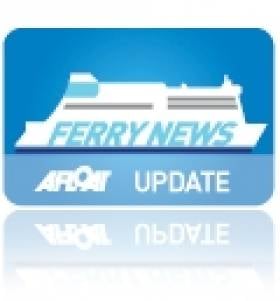Displaying items by tag: HSS Stena Explorer
Turkish Shipping Firm's Former Irish Sea Ferry Rides to the Rescue as Quake Victim Toll Rises
Following devastating quakes that took place last week in Turkey and neighbouring Syria, the toll rises to more than 33,000 people confirmed dead.
In addition as Tradewinds reports, to the hundreds of thousands losing their homes in freezing temperatures and this is where maritime companies are rushing to offer help.
As part of contributions to assist, the most eye-catching has involved Istanbul-based Karadeniz Holding, which announced on Saturday that it was to send two vessels into the stricken region and from where be able to host a total of 3,000 victims on board.
The contribution Karadeniz has described as its first humanitarian mission ever with the deployment of a pair of “Lifeship Floating Villages”. The vessels will be sent to the affected areas of Hatay and Iskenderun.
The ships to be deployed are the Karadeniz Lifeship Suheyla Sultan and the Karadeniz Lifeship Rauf Bey. (The latter lifeship, Afloat.ie has identified as the former Irish Sea fast-ferry HSS Stena Explorer which was renamed One World Karadeniz (see photo) prior to departing Holyhead and when bound for Turkey.
This was the first renaming given by Karadeniz after acquiring the pioneering HSS Stena Explorer which was the last ever ferry to operate the former Dun Laoghaire-Holyhead which closed in 2014).
At the weekend, Karadeniz added on social media that the lifeships are “fully equipped with accommodation, living spaces; education, social and medical facilities, dining halls and galleys”.
Anadolu, Turkey’s state-run news agency had said that the floating villages will be deployed in 15 to 20 days after “necessary procedures” are completed.
The lifeships reports Tradewinds are not currently listed on the fleet list of Karadeniz Holding, which deploys floating power stations in several troubled and energy-hungry parts of the world.
Karadeniz which also has an office in Dubai, has operations also in finance, real estate, and shipbuilding industries. On a related note as Afloat reported in 2015, they had plans to convert the HSS Stena Explorer into a high-tech floating office
For more on the floating village ships and their humanitarian relief role, click here.
Stena Line HSS Fast-Craft Sailings Cancelled
#SailingsCancelled – According to the Stena Line website, today's (Friday 22 March) HSS Stena Explorer fast-craft sailing departing at 13.30HRS from Dun Laoghaire to Holyhead has been cancelled.
All passengers en route to the port are advised to contact the Stena Line (24hrs) ferrycheck number (01) 204 7799 for the most up-to-date information about the sailings.
In addition to consulting information from this LINK.
Stena HSS Is Back for Easter and Summer Service
#HSSisBack–The HSS Stena Explorer fastcraft is back on the Dun Laoghaire-Holyhead route and Stena Line have a 'super spring sale' giving customers the opportunity to save up to 20% off its lowest fares.
The offer is available for travel up until 30 June from Dublin-Holyhead, Rosslare-Fishguard and on the Dun Laoghaire-Holyhead seasonal-only service.
Diane Poole Head of Stena PR and Communications said: "With Easter just around the corner and school holidays, we're offering customers the chance to enjoy a short break without breaking the bank".
The sale which starts with a lowest fare of €89* single (see web for T&A) for car and driver is now available every day of the week allowing people to save up to 20% on travel when they book by 28 February.
The HSS will operate one departure from Dun Laoghaire and Holyhead daily during this season, for information on the Spring sale and more visit: www.stenaline.ie/sale
Stena Send in ‘Freight-Only’ Ferry to Replace Damaged Chartered Ferry
#FerryBackUp – Freight ferry Stena Scotia (1996/13,017grt) docked in Dublin Port yesterday for 'berthing trials' and is to provide extra capacity for freight customers next week, writes Jehan Ashmore.
She is a replacement to the damaged chartered ferry Finnarrow, which as previously reported has since reached Scotland, with a tug berthing in Greenock.
The Dutch flagged Stena Scotia (capacity: 114 trailer units) will start freight-sailings next Monday (25 February) to Holyhead, where the 12-driver-accompanied vessel had called en-route yesterday also for berthing trials, having made an overnight passage from Belfast.
It was at the Anglesey port last weekend, where an incident involved the Finnarrow's stabilisers that led to cancelled sailings.
Stena Scotia will run in tandem with ro-pax Stena Adventurer (which takes passengers) on the Dublin route. There will also be additional passenger back-up with fastcraft HSS Stena Explorer sailings on the Dun Laoghaire-Holyhead route.
All passengers are advised to call Stena Line ferrycheck number 08705 755 755, for the most up-to-date information on sailings for 'foot' and those that are 'vehicle-only' by clicking this LINK.
The other regular Dublin route serving ro-pax Stena Nordica is as previously reported on refit cover on the North Channel and is expected to return to service on 19 March.
Stena Scotia (and sister 'Hibernia') had been lying idle in Belfast since September, having been replaced by larger chartered tonnage in the form of newbuild sisters, Stena Performance and Stena Precision.
The pair (from a quartet of newbuilds built last year) operate Stena's Belfast-Heysham freight service, following a short career starting off on the Irish Sea for operators Seatruck.
She has seen a succession of name changes in recent years, as Scotia Seaways under the navy blue colours of DFDS Seaways during a brief entry into the Irish Sea market in 2010.
Before that, she sported the pale blue livery scheme under Maersk / Norfolkline North Sea service as the Maersk Exporter completed in 1996.
HSS Off-Service till Second Year of Seasonal Summer Sailings
#HSS FASTCRAFT – Now that the HSS Stena Explorer has completed her Dun Laoghaire-Holyhead sailings on the day before Little Christmas, it would seem to be part of human nature to only value something when it is lost and only to know how precious it is when it returns, writes Jehan Ashmore.
The HSS had operated albeit briefly "12" days of service over the festive period, in what was somewhat of a surprise move by Stena Line to re-introduce these special sailings, considering that they did not take place during the same season of Winter 2011.
As previously reported on Afloat.ie, in that year, for the first time, the daily operated services on the route closed, breaking a historical link of around 200 years of continuous 'ferry' services. So in the following year, 2012 was marked as the first to operate a seasonal-only service running from Spring to September.
The reduction in sailings could not be so stark since the HSS's introduction in 1996, from the heydays of up to five daily round-trips during peak-season times. A decade later the service began to decline, with reduced frequency and longer passage times.
Despite last weekend's final sailing, the HSS reopens the route for a second year of seasonal-only summer sailings starting 22 March to early September. Once again many will welcome the sight of the HSS looming over the horizon from the Kish Lighthouse and speeding her way across Dublin Bay before entering the harbour mouth.
HSS Sailings Coincide with Ferry Firm’s ‘Festive’ Foundation
#STENA LINE 50TH – The return today of Stena Line's HSS fastcraft festive-season Dun Laoghaire-Holyhead sailings, also marks the 50th anniversary of the Swedish-owned ferry company's maiden voyage 'Christmas Trips' across the Skagerrak, writes Jehan Ashmore.
The contrast could not be so stark between ferry operations of half a century ago and today. The inaugural sailing in 1962 saw the 350 (passenger-only) M/S Østersøen embark with Gothenburgers looking for alcohol, tobacco and food bargains in Skagen at the very northern tip of Denmark.
Present-day vessels on the Gothenburg route albeit to Frederikshavn, are operated by Stena Danica, Stena Jutlandica and HSS Stena Carisma, a smaller version of the revolutionary HSS Stena Explorer.
When the 1,500 passenger capacity catamaran HSS Stena Explorer was introduced on the Dun Laoghaire-Holyhead route in 1996, she was a technological breakthrough, using gas-turbine-powered engines. She also made maritime history as the world´s first (HSS) high-speed sea service ferry put into service and the fastcraft was designed to handle large articulated lorries.
Five decades later the vision and enterprise of founder Sten A. Olsson, remains firmly rooted and as the Stena Line brand which has a route network connecting eight countries, served by more than thirty vessels, and employing 5,700 people, in an area stretching between the Irish Sea and the Baltic.
HSS Fastcraft is Back for Christmas and Beyond
#HSS FASTCRAFT- Stena Line's HSS fastcraft as previously reported on Afloat.ie is to return to the Dun Laoghaire-Holyhead tomorrow, operating the 2hour 15 minute service on 12 selected days during the festive period.
Christmas Sailing Schedule: The fastcraft HSS Stena Explorer will operate sailings on the following dates: 20-23 December, 27-30 December and also early into the New Year between 2-5 January 2013. During these dates the HSS will operate one departure from Dun Laoghaire and Holyhead daily. For HSS sailing schedules and also on the Dublin-Holyhead route, click LINK.
2013 Sailing Schedule: The fastcraft HSS return's to open the 2013 main season on the Dun Laoghaire-Holyhead route starting 22 March. The service will continue through the high-season months and until 10 September.
Stena Line are the only regular commercial company operating out of Dun Laoghaire Harbour and where as previously reported on Afloat.ie the port in 2013, its second season in developing the cruise sector, is to attract 10 cruise callers including Cunard Line's Queen Mary 2 in mid-May.
End of High-Season Stena HSS Sailings
#FERRY NEWS- Stena Line's seasonal-only Dun Laoghaire-Holyhead route run by the HSS Stena Explorer finished its last sailing today with a lunchtime departure bound for Anglesey. However the HSS service will return for twelve days over the Christmas / New Year period, writes Jehan Ashmore.
In the interim period the company will maintain their Dublin-Holyhead year-round route served by conventional ferries, Stena Adventurer and Stena Nordica. For information on the 3-hour 15 minute route and sailings schedules click HERE.
This is the second year in which the reduced HSS service has been operating to a single daily round trip, as Stena Line in recent years has strived to reduce costs on the 120 minute route served by the more expensive to run fuel-thirsty catamaran fast-ferry.
When sailings return on the Dun Laoghaire-Holyhead route during the festive period (see details), they are scheduled to run during three short stints, they are as follows: 20-23 December, 27-30 December and 2-5 January 2013.
Seasonal Start for Three In A Row
#FERRY NEWS – By this weekend three seasonal-only operated routes from the island of Ireland will have resumed service since the recent change of the clocks marking the start of summertime, writes Jehan Ashmore.
Sailings started today on Stena Line's Dun Laoghaire-Holyhead (120 minutes) fast-craft HSS Stena Explorer operated service. The central corridor route closed last September due to cost-saving measures as previously reported. For further details on sailing schedule click HERE.
The reopening of the Welsh route follows yesterday's launch of P&O Ferries fast-craft sailings to Scotland between Larne-Troon (2 hours) served by the 92m Express. She also runs additional sailings on the year-round Larne-Cairnryan route served by a pair of conventional ferry sisters. To read more information on both sailing route schedules click HERE.
The remaining route to re-open is Brittany Ferries Cork-Roscoff (14 hours) service operated by the 2,400 passenger 'flagship' Pont-Aven, which features an indoor swimming pool. Her first sailing for this year is tonight's sailing from the Breton port.
The corresponding Irish sailing departs tomorrow afternoon and the inaugural round trip is due to be completed with an arrival in France on Sunday morning. For sailing times click HERE.
Dun Laoghaire-Holyhead Service to Start Earlier than Planned
#FERRY NEWS- Stena Line have changed the resumption date of Dun Laoghaire-Holyhead HSS fast-craft operated sailings to 30th March, two days earlier than originally planned and as previously reported on Afloat.ie
The seasonal-only service is to operate a daily single round trip with a 10.00 hours sailing from Holyhead and a 13.15 hours sailing from Dun Laoghaire. Sailing times are 120-minutes and they will run throughout the summer months until 11th September.
Stena Line's Head of PR and Communications, Diane Poole, OBE said: "We look forward to welcoming the HSS Stena Explorer back on the Dun Laoghaire to Holyhead route which will provide customers with even more reason to cross the Irish Sea during the summer months.
"The vessel, which offers excellent onboard facilities, will complement the timetable on our Dublin Port to Holyhead route as it offers customers a mid-morning departure from Holyhead and a lunchtime departure from Dun Laoghaire."
For more information visit www.stenaline.ie or call 01 204 7777




























